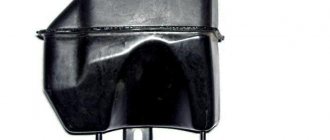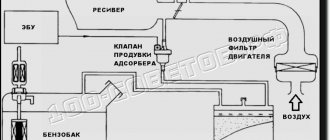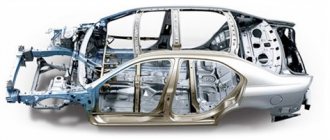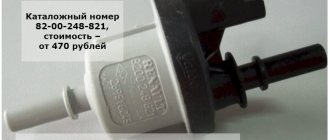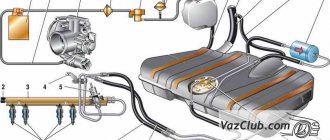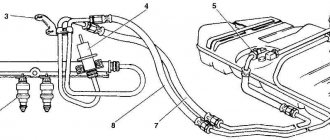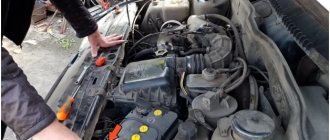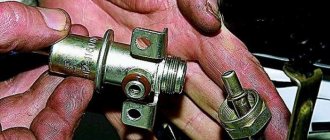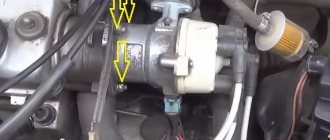As you know, the internal combustion engine of a car traditionally uses gasoline as the main type of fuel. Moreover, such a flammable and explosive petroleum product has an increased tendency to evaporate.
On the one hand, this is unsafe, and on the other hand, the result of the release of vapors is their release into the atmosphere and deterioration of the environment. So, to understand why an adsorber is needed in a car, it is worth noting that it is actually a filter for capturing gasoline vapors. This filter is installed in the ventilation system of the gas tank.
What is an adsorber and why is it needed?
An adsorber is an automotive system that collects gasoline vapors escaping from the tank. When the engine is running, vapors are redirected to the intake manifold system. If the engine is turned off, some of them are caught by the separator, again sent to the tank, and the rest goes to the adsorber with subsequent neutralization.
The adsorbent system is a large filter that captures light hydrocarbon compounds. The adsorber must comply with EURO-2 environmental standards, which imply the inadmissibility of polluting gasoline vapors from the vehicle from entering the environment. According to the same standards, the penetration of even small amounts of harmful compounds into the interior of the car is excluded.
Older cars did not have an adsorbent filter at all; they used a different cleaning system. Today, according to EURO-2 standards, a filtration system must be installed in all cars without exception.
How the adsorber works in a car: EVAP system
Despite the design differences and differences in the location of key elements, the air purification scheme from volatile fuel substances in all machines will work on an identical principle. The key element that purifies the air from unpleasant evaporation is a container filled with activated carbon.
After condensation, gasoline vapors enter the cavity of the container through a hose through a gravity valve. While the car engine is not running, the pressure in the tank increases and vapors accumulate in a special reservoir in the adsorber tank. Gradually, excess pressure forces excess air through the coal and out into the atmosphere. At the same time, the gasoline smell and harmful volatile substances are retained by the neutralizing agent.
The adsorber device has another valve, but it is already electromagnetic. When the internal combustion engine starts, the microprocessor (electronic control unit) controls the operation of this mechanism. The second canister circuit is connected to the intake manifold through a fitting connected to the same fuel tank.
When the pressure in the tank increases, the solenoid valve is activated. Since a vacuum is created in the intake manifold, gasoline vapors are sucked in, but in this case they no longer go through the carbon filter into the atmosphere, but along an easier path - into the intake system (more details on how it works are described separately ).
To prevent vacuum from forming in the gas tank due to the operation of the cleaning system, which would impede the operation of the gas pump, there is an air fitting in the adsorber tank. Through it, fresh air flow enters the separator if all excess vapor has already been removed. This process is called purging.
The advantage of such a system is that while the motor is running, the carbon filter remains unused. When gasoline vapors enter the vehicle's intake system, harmful substances are burned during the operation of the cylinders. Next, the exhaust gas stream is neutralized in the catalyst. Thanks to this, the smell of unburned gasoline is not heard near the car.
Device and principle of operation.
The design of a car's adsorbing system is quite simple. The adsorber is a large plastic jar filled with granular activated carbon, which works best with hydrocarbon compounds.
In addition to the filter part, the system consists of:
- Separator with a specialized gravity valve . The separator allows you to capture some of the fuel vapor and redirect it back to the tank. The gravity valve is mostly not involved and is activated only in emergency modes, preventing gasoline from spilling when the car overturns, for example, during an accident.
- Pressure sensor . It is used to control the vapor pressure inside the fuel tank.
- Solenoid valve . The most important switching component of the system, which opens when the engine starts.
- Filter with carbon granular powder . Serves to retain vapors.
- Connecting tubes . Provide supply and connection of all the above parts.
The principle of operation of the adsorber is as follows: vapors move up the tank and are retained by a separator combined with a gravity valve. Here, part of the vapor condenses and returns back in the form of liquid fuel, and the remaining part of the vapor, bypassing the gravity valve, passes into the filter jar, accumulating there. Accumulation occurs while the engine is not running.
The key element of the adsorption system is the solenoid valve. Starting the engine is accompanied by its opening - the adsorber is connected to the throttle element or intake manifold, depending on the type of car.
The purge process starts, during which the vapors are mixed with air from the environment and enter the engine cylinders. Here the air-fuel mixture burns.
Where is the adsorber located?
Logically, since the adsorber prevents direct contact of gasoline vapors from the tank with clean air, then it should be located either in the gas tank itself or near it. In fact, the automaker itself decides where to install the key element of the system in the car. Thus, domestic car models (Lada) are equipped with an adsorber, which in almost all versions is located under the hood near the right headlight.
In other brands, this element may be located in a niche along with the spare tire, on the fuel tank itself, under the fender liners, etc. Take, for example, Audi, models A4 and B5. In them, depending on the year of manufacture, the adsorber was installed in completely different departments of the car. In the Chevrolet Lacetti it is generally located under the trunk near the right rear wheel. To clarify where this element is located in a particular case, you must refer to the vehicle’s operating manual.
Signs of a malfunctioning adsorbent system.
Most adsorption system problems occur when the solenoid valve is faulty. It is open or closed, respectively, when the engine starts or stops. A normally operating solenoid valve does not make itself felt at all. Its malfunction, when the system is not purged and the pressure in the tank is not relieved, threatens serious damage to other parts of the car.
Problems with the adsorber are usually accompanied by the following symptoms:
- 5-10 minutes after the engine warms up, the revolutions begin to “float”;
- when you press the gas pedal at idle with the engine running, the latter behaves as if it were running out of fuel, up to a complete stop;
- when driving, the car does not develop full power, it feels like it is working at 80-90% of the maximum;
- the fuel tank sensor shows incorrect data, sometimes it can be “full” or, conversely, “empty”;
- when opening the tank during refueling, a whistling sound is heard, as if the container is sucking air from the environment;
- there is clearly overestimated gasoline consumption;
- Sometimes when the engine is not warmed up, the absorber knocks; the sound can easily be confused with the knocking of engine valves.
If the above symptoms are present, the solenoid valve must be checked. The faulty component must be replaced. The part is inexpensive and can be changed quite easily even on your own.
Signs of a malfunction of the adsorbent system are not always associated only with problems with the solenoid valve. Very often the filter jar containing the carbon powder gets clogged. If necessary, the part is changed or disassembled and cleaned (dried), restoring its filtering properties.
How to change only the valve?
There are situations when only the adsorber valve needs to be replaced. In this case, it is enough to spend 5-10 minutes of personal time to complete the entire range of work.
The valve is sold in any store, and its price (for VAZ cars) is only 600-1000 rubles.
At the same time as the valve, it is worth changing the adsorber sensor, because its functions include controlling the valve. Replacement is required if there are noises that resemble crackling.
It is necessary to begin work by diagnosing the serviceability of the valve. This is done as follows:
- Prepare a couple of wires and a multimeter.
- Release the retainer and remove the harness block from the purge valve.
- Connect the negative conductor of the multimeter to the ground of the car.
- Turn the key in the ignition and measure the voltage at output “A”. Normal voltage is 12 Volts. If it is not there, then there are two options - the ECU has failed or the battery is discharged.
- Loosen the clamp securing the tube to the valve and remove the hose from the pipe. Using a screwdriver, remove the valve from the adsorber, and then apply 12 Volts from the battery. The “positive” wire goes to terminal “A”, and the “negative” wire goes to “B”.
- As soon as voltage is applied to the connectors, the valve opens (a characteristic click is made). If this does not happen, then the valve is changed.
The valve is replaced according to the following algorithm (using the example of the VAZ-2114):
- Discard the “minus” from the battery;
- Discard the plug from the CPA;
- Release the inlet pipe clamp to gain access to the valve;
- Remove the device from the mass air flow sensor and move it to the side;
- Bend the valve clamps and dismantle the device;
- Move the mount to the side one centimeter;
- Pull the valve along the grooves;
- Discard the supply fittings. There may be problems with the second fitting, which has a special latch. To dismantle it, you need to tighten the special plastic antennae. This is easy to do - just recess the latch when the fitting is slightly raised up.
- Installation of a new device is carried out using the reverse algorithm.
Is it possible to remove the adsorber? Pros and cons of turning off the system.
The adsorbent system is an integral component of a modern vehicle. A properly functioning filter does not affect the functioning of the engine. Moreover, it allows you to save a little on gasoline, because the trapped fuel vapors are not thrown out, but burn in the engine.
Is it possible to ignore environmental standards and remove the adsorber from the car? This can be done, and it will not affect the operation of the car in any way. From a technical (but not environmental) point of view, this is even better - vapors from the tank will escape directly into the environment, and without additional cans, valves and tubes, the reliability of the car will increase.
It is not difficult to carry out this manipulation - you need to connect a fine filter to the separator through a hose, shut off the adsorber itself and do chip tuning (engine firmware).
Disabling the adsorber has other positive aspects:
- the engine compartment space is significantly freed up, because the system (especially the filter bank) takes up a lot of space;
- the known problem of unstable engine idle operation disappears;
- There is a small cost savings due to the unnecessary purchase of a new adsorber and valve in the event of their breakdown.
At the same time, we should not forget what threatens the shutdown of the adsorbing system, namely:
- There will be a smell of gasoline inside the car, because some of the vapor will go into the cabin;
- light hydrocarbons will be released into the atmosphere and pollute the environment;
- the car itself (outside) may also begin to smell of fuel.
About why an adsorber is needed, how it works, and how to check it, see the following video:
The adsorbent system is a fairly simple but useful component of a car. Maintenance of this element is not difficult or expensive, but if desired, you can go against environmental standards and turn off the adsorber, slightly increasing the reliability of the machine.
That's all for me today. If you have any questions, or if you want to add to the article, write comments.
Best regards, administrator
Malfunctions, inspection and repair
The ventilation system is very reliable, but problems occur here too. They are mainly associated with the aging of parts; the tightness of the lines, the housing may be compromised, or malfunctions in the operation of the purge valve may occur. In this case, both external signs of a malfunction of the adsorber are observed, as well as those noticed by the system from the inside, with the display of an error signal on the dashboard, memorizing its code and switching to emergency mode.
- As a rule, the first manifestation is unstable operation of the engine after warming up, when purging should begin, but for some reason this does not happen. Either additional air is sucked in, which leads to an increase in speed, since this air is not taken into account by the flow meter, or vice versa, the system assumes that the mixture is being released from the valve side into the manifold, but it is not there, the engine does not respond as expected.
- Changing the mixture composition will cause failures in engine operation, especially during the transition from idle to medium speed. These same violations lead to something that almost always accompanies problems with the power system - traction drops and consumption increases. Moreover, diagnosticians often forget about the adsorber and try to look for a problem elsewhere.
- To clarify the reasons, the control unit issues error codes; they are usually concentrated in the range from P0440 to P0455 . The scanning program will always decipher the codes and hint where to look for a fault.
The method for checking the adsorber is quite simple. First of all, you need to make sure that the housing is tight, creating a vacuum sequentially on each of the pipes, blocking the others. Then, clogging of the air hose is eliminated, which does not work under the best conditions due to dust and dirt, especially if it has been torn from its normal place.
The purge valve is checked using the same method, for vacuum. Typically valves are normally closed, meaning they should not allow air to pass through unless power is applied to it. Conversely, when there is a signal at the connector, the valve opens with a characteristic click. During normal operation in modulation mode, it should produce a clearly audible crackling sound. It is especially convenient to check the valve by connecting an adapter to the diagnostic connector under the control of a program that allows you to change the frequency of the control signal. Valves stuck in one position and soured, or that have lost their performance due to wear and contamination, may respond to single operations, but not operate at normal frequency. There is no point in repairing valves; they are inexpensive, and it is easier and more reliable to replace them with new ones.
The adsorber itself will cost a little more, especially if it is not a simple product from an unknown manufacturer, but a full-fledged device with the capabilities of the original. But it will have to be replaced; the tank ventilation system is so deeply integrated into the car’s power supply that introducing changes into it, all kinds of plugs and bypasses, can cost much more. It’s much safer to install new parts, replace the valve and hoses, and then forget about ventilation for a long time. In addition, everything related to the power supply system, that is, gasoline, has a high fire hazard; saving here is unacceptable. The destruction of the “left” adsorber, filled with concentrated vapors in the hot engine compartment, can destroy the car.
The answer to the question posed earlier, what is an adsorber in a car and why is it needed, can be further clarified in the application to a specific car. The designs differ significantly; perhaps some components in the review are not covered. But they are of secondary importance; the very physical principles underlying the environmental friendliness of storing fuel in a car are approximately the same for all cars.
Diagram of the fuel vapor recovery system on Priora: design and designation of the main elements
The diagram of the gasoline vapor recovery system on Priora is as follows:
Fuel vapor recovery system VAZ-2170
In the diagram, each element has a corresponding name and purpose. The name of each item is listed in the description below:
The purpose of each element of the system is described in detail in the material below.
This is interesting! The vent tube numbered “9” is designed to remove air from the tank as it fills with fuel.
Air filter absorber
We were talking about the fuel absorber. In addition to this, the air filter has its own absorber, which solves completely different problems:
- Reduces noise levels by dampening sound waves from the explosion of the fuel mixture in the combustion chamber.
- Distributes and regulates oncoming and outgoing air flows, ensuring uniform air access and preventing turbulence.
- Prevents condensation from forming due to temperature differences between a hot engine and cold air and moisture from entering the engine.
- Installed directly on the air filter. Operating a car without this unit is unacceptable.
Where is the adsorber located on Priora and how to replace it
It should be emphasized once again that often the cause of a malfunction of the fuel vapor recovery system is the solenoid valve, so troubleshooting should begin with it. If this part on the Priora is working properly, then there is a high probability that the adsorber has failed. To replace it, you must first understand the location. Typically such devices are located next to the gas tank, but not always. On a Priora, the adsorber is located in the engine compartment. You need to look for it next to the generator under the right headlight. The photo below shows the location of the adsorber on a Priora with air conditioning.
It is important to note the fact that the Priora can have an adsorber, both rectangular and round.
Despite the differences in shape, the products are completely interchangeable.
The photo below shows the location of the element on the radiator side.
Now let's figure out how the adsorber is removed on a Priora. The process will be slightly different depending on the vehicle configuration. If the Priora is 8-valve and without air conditioning, then the process of removing the adsorber is as follows
:
- Initially, you should disconnect the hose fastenings “3” and “4” in the figure below. To do this, press the latches and pull the hoses.
- Using a wrench at “8”/“10” (may differ), unscrew the fastening bolts (2 pcs.). For unscrewing, it is recommended to use a spanner wrench with a ratchet, since they are the most convenient for unscrewing fasteners in hard-to-reach places.
- After this, you can remove the part. There is enough space to remove it, and you do not need to remove the generator or headlight to do this.
- Check for serviceability or replace. Installation is carried out in the reverse order of removal. When installing, it is important to observe the tightening torque of the mounting bolts. They are tightened with a force of 1.6-2.8 Nm.
However, the process of dismantling the gasoline vapor trap is not difficult on a Priora without air conditioning, where there is free access to the device. On 16-valve VAZ-2170 models with Halla and Panasonik air conditioners, the process will be slightly different. The difference is that you need to remove the right headlight, under which the adsorber is located. The principle of dismantling the adsorber is to perform the following actions:
- First you need to remove the top trim from the headlight by unscrewing the four fasteners using a Phillips screwdriver.
- Disconnect the power supply from the headlight from the inside using a screwdriver.
- After this, you need to loosen the bumper (right side). How to properly snap off the bumper so as not to damage it is described here.
- This is necessary in order to gain access to the mounting bolt, which is located under the headlight. We unscrew it.
- Unscrew the Phillips screwdriver located on the side.
- The headlight is secured with three fasteners. The third bolt is at the top. After unscrewing it, you can remove the headlight to gain access to the adsorber for subsequent removal.
Interesting! The detailed process of removing headlights on a Priora is described in this article.
Having gained access to the adsorber, disconnect the hoses from the device and unscrew the two fastening screws. We remove the device, check it or change it.
Assembly is performed in the reverse order of dismantling. The example of removing the generator shows how to get to the adsorber on a Priora with air conditioning.
This completes the procedure for replacing the adsorber on a Priora with and without air conditioning. Despite the laboriousness of the process, everything is done very quickly and without the need to visit a car service center.
The procedure for removing the adsorber
When purchasing a new vehicle engine ventilation unit, pay attention to the markings. Both should be identical. Otherwise, there will be no compatibility and the valve will not be able to work and provide ventilation to the gas tank.
The replacement procedure is as follows:
- Remove the negative terminal from the battery.
- Open the hood and find the absorber.
- Press the latch that holds the wire block. And disconnect it.
- Unscrew the screws that hold the device in place.
- Disconnect the hoses.
- Remove the bracket and the old piston from the absorber.
- Install a new device.
- Repeat all steps in reverse order.
Attention! To assemble in the same order, you need to mark each device with a marker in what order it was removed.
In this simple way, a new device for venting the EVAP system is installed.
Like all devices, this type of absorber has its positive and negative sides. Due to the disadvantages, experienced car owners most often remove the valve. Although this threatens to destroy the coordinated work of the mechanisms.
Bumper absorber
This element is fundamentally different from those described above. Its task is to absorb (sorb) the kinetic force of impact in the event of a car collision. It is hidden under the bumper lining and upon impact is crushed, absorbing part of the impact energy. Can be made of rated density foam, monolithic plastic or plastic balls.
Today, such elements are not found on all cars, although they can be installed at a car service center if desired. But most likely, in the near future this will be a mandatory element of passive protection on all cars. At the same time, crash tests will be carried out to test the effectiveness of the design and materials, the element will be improved and become more efficient. As a result, this will really help improve traffic safety.
Consequences of dismantling the adsorber
Some motorists are confident that increasing the environmental parameters of a car always negatively affects the efficiency of the power unit and the dynamics of the vehicle. For this reason, they remove everything that they think is “interfering” with the operation of the unit. In fact, the adsorber does not affect the performance of the internal combustion engine, but its absence does, since the design of the fuel system provides for its presence, and it must ventilate the tank through this device.
Those who claim that this neutralization system somehow affects gasoline consumption in the direction of reducing this parameter may also be mistaken. This is so because only a small amount of gasoline is returned to the tank, which in a regular car simply evaporates into the atmosphere. However, these savings are so insignificant that they cannot be felt during the operation of the vehicle.
As for the environmental friendliness of the machine, in this case this parameter is reflected only in the diagnostic equipment. Compared to the operation of a catalyst or the same AdBlue system, which is discussed separately , the EVAP function is not so noticeable.
If during the diagnostic process it was revealed that the problems are related specifically to the EVAP system, you cannot remove the adsorber and connect the tubes coming from the gas tank and intake manifold directly without a filter. More precisely, this is physically possible, however, without a filter element and valve in the process of constantly sucking part of the air from the tank, it can lead to damage to the fuel tank, and in some cases, gasoline vapors with fuel particles entered the intake manifold.
In the second case, the electronic control unit will not be able to efficiently form the VTS, and the engine will receive an over-enriched mixture. This will certainly lead to the fact that the exhaust gases will contain a large amount of harmful substances. Such disruption of the power unit increases the load on the catalyst, and this is a very expensive part in the car.
If a motorist decides to remove the system as unnecessary and useless, and plug the pipes, then in this case he will not be able to avoid difficulties with the operation of the car. A large amount of vapor will accumulate in the tank, which will lead to unstable operation of the internal combustion engine due to high gasoline pressure in the tank.
For these reasons, if the adsorber fails, either cleaning it or replacing it with a new one will help (it all depends on the type of malfunction).
